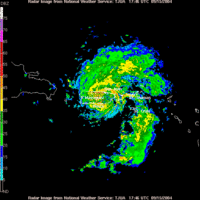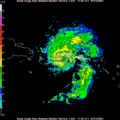Effects of Hurricane Jeanne in Puerto Rico facts for kids
| Tropical storm (SSHWS/NWS) | |

Radar image of Jeanne striking Puerto Rico
|
|
| Winds | 1-minute sustained: 70 mph (110 km/h) |
|---|---|
| Pressure | 991 mbar (hPa); 29.26 inHg |
| Fatalities | 4 direct, 4 indirect |
| Damage | $169.5 million (2004 USD) |
| Areas affected | Puerto Rico |
| Part of the 2004 Atlantic hurricane season | |
Hurricane Jeanne caused a lot of damage in Puerto Rico in 2004. It was the worst storm there since Hurricane Georges in 1998. Jeanne was the tenth tropical storm of the 2004 Atlantic hurricane season. It hit Puerto Rico on September 15 with winds of about 70 miles per hour (110 km/h).
As the storm moved across the island, it brought very heavy rain. Some areas, like Aibonito, got over 19 inches (480 mm) of rain. The island of Vieques got even more, with a total of 23.75 inches (603 mm). This heavy rain led to widespread flooding and many landslides. It also caused a lot of damage to crops.
Winds reached 72 miles per hour (117 km/h) in Cayey. The strong winds and heavy rain left most of Puerto Rico without electricity or water. Before the storm hit, the governor of Puerto Rico ordered the island's power to be turned off. This was done to prevent dangerous electrical accidents.
After the storm, power and water were slowly brought back. The damage from Jeanne cost about $169.5 million (in 2004 money). Because of this, then-President George W. Bush declared Puerto Rico a disaster area. This meant that the government could send money to help. Over 155,933 people received $401.1 million in aid. Sadly, Jeanne caused eight deaths in Puerto Rico. Four of these were directly from the storm. Because of the serious damage it caused, the name "Jeanne" was later removed from the list of hurricane names.
Contents
Getting Ready for Hurricane Jeanne
Hurricane Jeanne started as a tropical depression on September 13. It formed from a weather system east of the Lesser Antilles. The United States government quickly issued a tropical storm warning for all of Puerto Rico. This warning came about 43 hours before Jeanne reached the island.
As the storm moved through the Caribbean Sea, it got stronger. By late on September 14, experts thought Jeanne would become a small hurricane when it crossed Puerto Rico. So, the tropical storm warning was upgraded to a hurricane warning. Jeanne finally made landfall on September 15. It hit at 4 PM UTC as a 70 mph (110 km/h) tropical storm. This was about 17 miles (29 km) east of Guayama.
Before the storm, 3,629 people went to 159 schools that were turned into emergency shelters. All ports around the island were closed, and most flights were canceled. The governor ordered the entire island's power grid to be shut down. This was to prevent serious electrical accidents from fallen wires. This decision was made because six people had died from similar accidents during Hurricane Hugo in 1989. Also, ferry trips to the islands of Vieques and Culebra were stopped.
In Vega Baja, an older man sadly died while putting up storm shutters. As Jeanne moved ashore, it was trying to form an eye. This showed that its winds were almost at hurricane strength. Higher areas of the island did experience hurricane-force winds. Jeanne quickly moved across Puerto Rico. It then became a full hurricane in the Mona Passage, between Puerto Rico and the Dominican Republic.
How Hurricane Jeanne Affected Puerto Rico
When Hurricane Jeanne hit Puerto Rico, it brought strong tropical storm winds. A weather worker reported steady winds of 63 mph (101 km/h) in Salinas. Gusts there reached 71 mph (114 km/h). In Cayey, in the middle of the island, a gust of 72 mph (117 km/h) was recorded. This was just below hurricane strength. The Luis Muñoz Marín International Airport in San Juan also reported steady winds of 49 mph (80 km/h).
Most of Jeanne's impact came from its heavy rainfall. The island of Vieques got the most rain, with 23.75 inches (603 mm) over three days. In one 24-hour period, Vieques received 14.75 inches (375 mm) of rain. This was a very rare event, expected only once every 100 years. On the main island of Puerto Rico, rainfall was generally between 5 and 15 inches (127–381 mm). The highest amount was 19.2 inches (488 mm) in Aibonito. There, 15 inches (380 mm) fell in 24 hours, also a 1-in-100-year event. The island of Culebra also got heavy rain.
The heavy rainfall caused severe flooding along many rivers in Puerto Rico. This forced 3,629 people to leave their homes in flood zones. Across the island, Jeanne caused many mudslides and landslides. The storm also damaged the water system, costing $8 million (in 2004 money). About 600,000 people were left without running water.
Hurricane Jeanne caused a lot of damage to schools, homes, and businesses. Strong wind gusts left 70% of the island without electricity. Damage to the power lines cost $60 million (in 2004 money). Many roads were closed because of fallen trees, landslides, and debris. About 302 roads were affected, and many bridges were damaged.
The storm also caused heavy damage to crops in the southern and eastern parts of the island. Coffee, plantain, banana, and wheat crops were especially hit. In Jayuya, 30% of the coffee crop was destroyed. Over half of the $101.5 million in crop damage was to banana crops. In total, more than 15,500 acres (6,300 hectares) of farmland were affected.
Overall, Hurricane Jeanne directly caused four deaths and indirectly caused another four in Puerto Rico. The total damage was $169.5 million (in 2004 money). This made it the most damaging tropical cyclone since Hurricane Georges in 1998.
After the Storm
After Hurricane Jeanne passed, two people sadly died from breathing in dangerous fumes from a generator. This happened because the generator was running in a closed space without proper air flow. Two other people died, and one was hurt, when a tree damaged by the winds fell on their car near Yauco. Because water supplies were contaminated, authorities told people to boil water before drinking it. The day after the storm, electric companies restored power to many areas. However, 870,000 people were still without electricity. The western part of the island, hospitals, and the Luis Muñoz Marín International Airport were among the first places to get power back.
On September 17, two days after Jeanne hit, U.S. President George W. Bush declared Puerto Rico a disaster area. This meant that the government would help pay for cleaning up debris and for emergency services. Right after the storm, the Federal Emergency Management Agency (FEMA) helped fund crisis counseling for storm victims. This was set up by the Puerto Rico Department of Health.
FEMA also opened six disaster recovery centers. Over 206,000 people asked for disaster help, including money for important repairs and temporary housing. FEMA approved requests for 155,933 people, providing $401.1 million in aid. In March 2005, the U.S. Government gave $14.6 million for rebuilding projects. This included fixing the power grid and repairing roads and bridges.
Because of the widespread damage it caused, the World Meteorological Organization decided to retire the name "Jeanne" in Spring 2005. This means the name will never be used again for an Atlantic hurricane. The name was replaced by Julia, which was used in the 2010 season.
Images for kids



